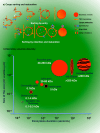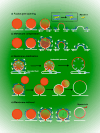Multiple roles for the actin cytoskeleton during regulated exocytosis
- PMID: 22986507
- PMCID: PMC4052552
- DOI: 10.1007/s00018-012-1156-5
Multiple roles for the actin cytoskeleton during regulated exocytosis
Abstract
Regulated exocytosis is the main mechanism utilized by specialized secretory cells to deliver molecules to the cell surface by virtue of membranous containers (i.e., secretory vesicles). The process involves a series of highly coordinated and sequential steps, which include the biogenesis of the vesicles, their delivery to the cell periphery, their fusion with the plasma membrane, and the release of their content into the extracellular space. Each of these steps is regulated by the actin cytoskeleton. In this review, we summarize the current knowledge regarding the involvement of actin and its associated molecules during each of the exocytic steps in vertebrates, and suggest that the overall role of the actin cytoskeleton during regulated exocytosis is linked to the architecture and the physiology of the secretory cells under examination. Specifically, in neurons, neuroendocrine, endocrine, and hematopoietic cells, which contain small secretory vesicles that undergo rapid exocytosis (on the order of milliseconds), the actin cytoskeleton plays a role in pre-fusion events, where it acts primarily as a functional barrier and facilitates docking. In exocrine and other secretory cells, which contain large secretory vesicles that undergo slow exocytosis (seconds to minutes), the actin cytoskeleton plays a role in post-fusion events, where it regulates the dynamics of the fusion pore, facilitates the integration of the vesicles into the plasma membrane, provides structural support, and promotes the expulsion of large cargo molecules.
Figures





Similar articles
-
Actin and Myosin in Non-Neuronal Exocytosis.Cells. 2020 Jun 11;9(6):1455. doi: 10.3390/cells9061455. Cells. 2020. PMID: 32545391 Free PMC article. Review.
-
Lipids implicated in the journey of a secretory granule: from biogenesis to fusion.J Neurochem. 2016 Jun;137(6):904-12. doi: 10.1111/jnc.13577. Epub 2016 May 2. J Neurochem. 2016. PMID: 26877188 Review.
-
Myosin motor proteins are involved in the final stages of the secretory pathways.Biochem Soc Trans. 2011 Oct;39(5):1115-9. doi: 10.1042/BST0391115. Biochem Soc Trans. 2011. PMID: 21936774 Free PMC article. Review.
-
Revising the Role of Cortical Cytoskeleton during Secretion: Actin and Myosin XI Function in Vesicle Tethering.Int J Mol Sci. 2021 Dec 28;23(1):317. doi: 10.3390/ijms23010317. Int J Mol Sci. 2021. PMID: 35008741 Free PMC article.
-
Actin is not an essential component in the mechanism of calcium-triggered vesicle fusion.Int J Biochem Cell Biol. 2006 Mar;38(3):461-71. doi: 10.1016/j.biocel.2005.10.008. Epub 2005 Nov 8. Int J Biochem Cell Biol. 2006. PMID: 16309945
Cited by
-
PKA-dependent phosphorylation of LIMK1 and Cofilin is essential for mouse sperm acrosomal exocytosis.Dev Biol. 2015 Sep 15;405(2):237-49. doi: 10.1016/j.ydbio.2015.07.008. Epub 2015 Jul 10. Dev Biol. 2015. PMID: 26169470 Free PMC article.
-
A genome-wide association study for natural antibodies measured in blood of Canadian Holstein cows.BMC Genomics. 2018 Sep 21;19(1):694. doi: 10.1186/s12864-018-5062-6. BMC Genomics. 2018. PMID: 30241501 Free PMC article.
-
Multiple essential functions of Plasmodium falciparum actin-1 during malaria blood-stage development.BMC Biol. 2017 Aug 15;15(1):70. doi: 10.1186/s12915-017-0406-2. BMC Biol. 2017. PMID: 28810863 Free PMC article.
-
Probing the role of the actin cytoskeleton during regulated exocytosis by intravital microscopy.Methods Mol Biol. 2014;1174:407-21. doi: 10.1007/978-1-4939-0944-5_28. Methods Mol Biol. 2014. PMID: 24947398 Free PMC article.
-
Cdc42 controls secretory granules morphology in rodent salivary glands in vivo.Commun Integr Biol. 2020 Feb 11;13(1):22-26. doi: 10.1080/19420889.2020.1724605. eCollection 2020. Commun Integr Biol. 2020. PMID: 32128025 Free PMC article.
References
-
- Burgoyne RD, Morgan A. Secretory granule exocytosis. Physiol Rev. 2003;83(2):581–632. - PubMed
-
- De Matteis MA, Luini A. Exiting the Golgi complex. Nat Rev Mol Cell Biol. 2008;9(4):273–284. - PubMed
-
- Bossi G, Griffiths GM. CTL secretory lysosomes: biogenesis and secretion of a harmful organelle. Semin Immunol. 2005;17(1):87–94. - PubMed
Publication types
MeSH terms
Substances
Grants and funding
LinkOut - more resources
Full Text Sources

